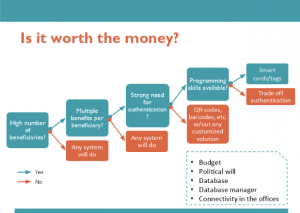Smartcards for MERL: Worth the Money?
by Jonathan Tan
In 2014, ACDI/VOCA ran into a common problem: their beneficiaries – smallholder farmers in Ghana – had been attending trainings for several agricultural programs, but monitoring workshop attendance and verifying the identity of each attendee was laborious, inaccurate, and labor-intensive. There were opportunities for errors with transcription and data entry at several points in the reporting process, each causing delays downstream for analysis and decision-making. So they turned to a technological solution: contactless smartcards.
At MERL Tech DC, Nirinjaka Ramasinjatovo and Nicole Chao ran a session called “Smartcards for MERL: Worth the Money” to share ACDI/VOCA’s experiences.
The system was fairly straightforward: after a one-time intake session at each village, beneficiaries are registered in a central database and a smartcard with their name and photo is printed and distributed for each. They hired developers to build a simple graphical interface to the database for trainers to use. At each training, trainers bring laptops equipped with card readers to take attendance, and the attendance data is synchronized with the database upon return to an internet-connected office.
The speakers discussed several expected and unexpected benefits from introducing the smartcards. Registration was streamlined at trainings, and data collection became faster and more accurate. Attendance and engagement at training sessions also increased. ACDI/VOCA hypothesized that beneficiaries possessing physical tokens associated with the otherwise knowledge-based program reminded them of its impact; one of the speakers recounted observing some farmers wearing the smartcards on lanyards with pride to non-training social events in the community. Finally, improved data tracking enabled analysts at ACDI/VOCA to compare farmers’ attendance rate at training sessions to their reported agricultural yield increases and thus measure their impact more effectively.

Process durations for developing the 2014 smart card system in Ghana (left), vs. the 2018 smart tags in Colombia (right).
Then came the perennial question: what did it cost? And was it worth it? For the 2014 Feed the Future program in Ghana, the smartcard system took 6 months of preparation to be deployed (including requirements gathering, software development, hardware procurement, and training). While the cards were fairly inexpensive at 50 to 60 cents (US) apiece, the system had not insignificant fixed costs: card printers were $1,500 each, and the total software development cost was between $15,000 to $25,000.
ACDI/VOCA sought to improve on this system in a subsequent 2018 emergency response program in Colombia. Instead of smartcards, beneficiaries were issued with small contactless tags, while enumerators used tablets instead of laptops to administer surveys and track attendance. Crucially, rather than hiring developers to write new software from scratch, they made use of Microsoft PowerApps that were more straightforward to deploy; the PowerApp-based system took far less time to test and train enumerators with. It also had the benefit of being easily modifiable post-deployment (which had not been the case with the smart cards). The contactless tags were also less costly at $0.10 to $0.15 apiece, with readers in the $15-20 range. All in all, the contactless tag system deployed in Colombia proved to be far more cost-effective for ACDI/VOCA than the smart cards had been in the previous Ghana project.

Based on the two projects discussed, the speakers proposed the following set of questions to consider for future projects:
- Is there a high number of beneficiaries in your program?
- Does each beneficiary have the potential to receive multiple benefits/programs?
- Is there a strong need for identity authentication?
- Do you have access to software developers?
If you answered “yes” to all four questions, then it is likely that a smart identification system based on cards, tags, etc. will be worth the upfront investment and maintenance costs. If, however, your answer to some or all of them was “no”, then there were intermediate solutions that could still be implementable, such as using tokens with QR codes or bar codes, which would not be as strict of a proof of identity.
You might also like
-
What does the data say? Join us for a roundtable on the emerging evidence on GenAI for Social & Behavioral Change
-
Event: “Should we be using AI right now?” A conversation about the ethical challenges of the current moment
-
Join us on May 15th for an AI+Africa Working Group Meeting: Shaping Our Priorities!
-
Event Recap: Tests of Large and Small Language Models on Common Evaluation Tasks
